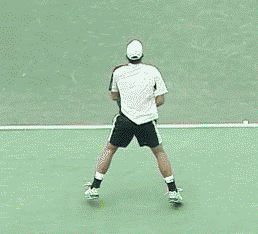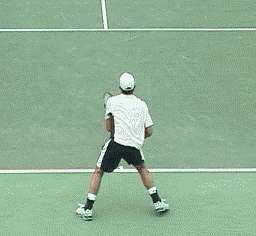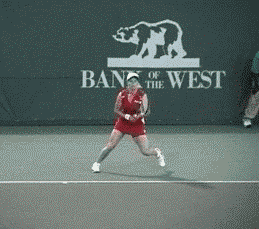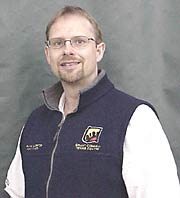|
TennisOne Lessons
Baseline Re-direct Game-Based Situation Training Wayne Elderton One of the most effective and practical ways to improve your game is to stop practicing strokes. Instead, practice shots in situations that re-create matchplay scenarios (see my last TennisOne article entitled: Learning the Language). Re-creating matchplay situations will allow the skills you learn to transfer more easily to reality, break down less under pressure, and win more points. This type of training (which I call Situation Training or ST), is the practical application of the international coaching trend called the Game-based approach (GBA). In this ST lesson, I will outline one of the most basic and common situations players encounter.
The Story You're a 3.5-5.0 level player engaged in a baseline to baseline exchange. Every time you put the ball solidly down-the-line (off your opponent's crosscourt), you get the advantage or, win the point outright. The trouble is, that happens way less than you missing, or your opponent taking your down-the-line and making you run madly to get the crosscourt reply. The result, you are losing more points than you are winning and your opponent is smiling way too much. The funny thing is, you have diligently practiced your down-the-line. Your coach has fed you countless shots, you've even drilled with a partner regularly (they hit crosscourts and you hit down-the-lines). It all seemed to work ok, at least in practice. You are familiar with the concept that a down-the-line is a lower percentage shot. It's not like you go for them all the time but surely, you should be able to do it successfully more often than this? The Situation Revealed We have entered the realm of a common challenge faced by the majority of players in baseline rallies: How to re-direct successfully (in this case, take an opponent's crosscourt and send it down-the-line). Using the Shot Situation chart I introduced in the last article, here is the layout:
Tactical Decision-making The main challenge players fail to consider is that the tactical decision made (when you choose it) is every bit as important as the technique. Decision-making is the foundation of smart tactical play, and playing smart maximizes chances to win (or make less errors). Why do you go down-the-line when you do? For most players, they re-direct the ball whenever they feel like it. Or, their decision is based on the ‘big space' they see as open court (which is like a brightly colored lure to an unsuspecting fish). Is this smart tactics?
The first concept players must understand is, “High Percentage” decision-making. In simple terms: Given 10 opportunities to hit that same shot, how many times would you make it? Answering less than 7 means you've made a “low percentage” choice. Choosing a low percentage time for the shot means, every time that situation repeats in a match, you miss more than get. Don't be fooled by the few chances you WILL make (and promptly talk about in the lounge after), you will never win the match! The ‘tennis math' is against you. In our re-direct scenario, learn the proper “Decision Triggers” that reveal it's a good time to re-direct. It's a matter of balancing risk. Too much risk leads to mistakes or lower quality shots opponent's can take advantage of. Too little risk and the opponent can capitalize more often than not. The right amount of risk gets the most advantage, most often, with the least errors. Excellent rallyers balance this risk the best on each and every shot. Roger Federer is an excellent example of shot selection. Watch him rally and you will see how he chooses to rally neutral on one ball, defend more on the next, force on the next, etc. The right shot for the right situation.
Decision-Triggers Typically, in a baseline rally, the ball received is a better decision trigger than the position of the opponent. The likelihood of hitting a winner on every down-the-line isn't high in a baseline exchange. This is where many players go wrong. Rather than looking to force a weaker ball out of the opponent and set something up, they see down-the-lines only as opportunities to end the point. How much pressure does that put on the shot? Is it high percentage? Do players recover well for the next shot when they think the point should be over? One can see the problem with wrong decision-making. When the opponent sends their crosscourt high, hard, or wide, a re-direction is risky. Remember, if you cannot hit a quality down-the-line, your opponent gets to hit the highest percentage shot in tennis (a crosscourt) and, since you are in the corner, the crosscourt puts you in the most trouble. In example one above, Andy Roddick is behind the baseline and out wide, so he chooses to maintain a rally crosscourt instead of hitting the much riskier down-the-line. This is one of the problems with the typical basket feeding or live ball, “you hit crosscourt, and I'll hit down-the-line on every 2 nd shot”, type drills. They teach going down-the-line at the wrong times!
The best trigger is identifying a “weaker” ball, one that doesn't challenge your reception skills. Weaker means one or more of these factors:
Example 2 shows Roddick choosing a down-the-line since the ball fits all of the criteria above. Recovery Remember, this is a baseline rally situation. We are not talking about balls that are so short players can approach the net. After a re-direction, good recovery is a must. To cover all the appropriate angles, move to the opposite side of centre. If your opponent looks like they are going to be stretched, hold the baseline and look for the shorter ball. If it looks as though they will get to your re-direction in good time, recover behind the baseline.
Decision Drill I recommend two simple drills to improve your situational re-direction skills. Drill #1: Have a coach or partner feed a variety of balls from the opposing crosscourt corner (to re-create the real angles). Call “Line” when a weaker ball is identified and re-direct it. Call “Cross” when a line is risky and send it back crosscourt. To put some pressure on, score one point for every successful re-direct, minus two for a botched attempt. To minimize the, “it's all over after a down-the-line” syndrome, make sure the feeder goes over to the down-the-line corner and returns the ball (as an alternative, another player can be stationed there). No point is awarded if you don't return the ball after your re-direct. Play to 10 points. Drill #2: With a partner, rally cooperatively crosscourt (alternate starting to the backhand and forehand corners). Whenever a weaker crosscourt is identified by either player, they can then go down-the-line. Points don't begin until a down-the-line shot occurs. Then play out the point competitively. Play to 7. Practicing this situation will help you dominate baseline exchanges while maintaining consistency. Next installment: The re-direct point story continues. How to weave re-directions into a dominating baseline strategy? How to respond to a good re-direction? Your comments are welcome. Let us know what you think about Wayne Elderton's article by emailing us here at TennisOne.
|
||||||||||||||||||||||||||||||




 Wayne Elderton
Wayne Elderton